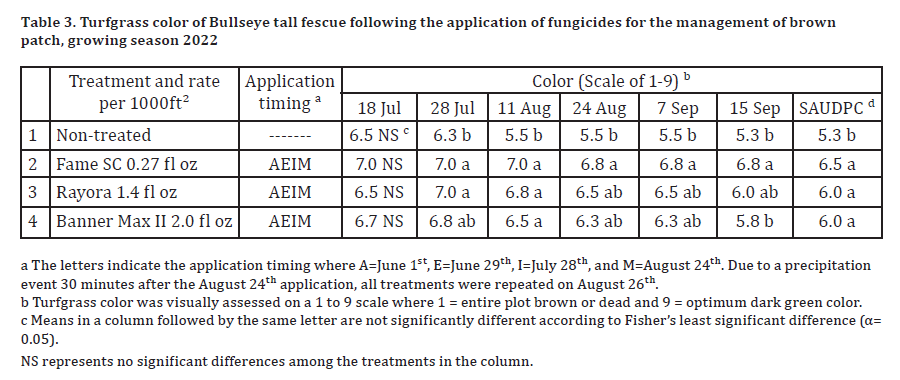Evaluation of Fungicides for the Management of Brown Patch (Rhizoctonia solani) on Tall Fescue (Festuca arundinacea)
Fereshteh Shahoveisi, Department of Plant Sciences and Landscape Architecture, University of Maryland, College Park
Brown Patch (caused by Rhizoctonia solani) is one of the important turfgrass diseases commonly observed in home lawns in the Mid-Atlantic region. A field study was carried out at the Paint Branch Turfgrass Facility (University of Maryland) to evaluate the efficacy of some fungicides in the management of the disease. Tall fescue cv. Bullseye with a 3-inch height of cut was used to test fungicides and a non-treated control. Treatments were applied approximately every 28 days beginning June 1st until August 26th, 2022. A total of 2 gal /1000 ft² fungicides in 3×6 feet plots were sprayed at each application using a CO2 backpack sprayer equipped with a Teejet AI9508E nozzle. A randomized complete block design with four replications was used. Brown patch disease severity (percentage), quality and color (1-9 scale) were measured every two weeks after disease onset in mid-July until three weeks after the last application. Urea fertilizer was applied twice (0.9 lb/ 1000 ft² on June 6th and 0.5 lb/1000 ft² on July 6th). The experiment was concluded on September 15th as the disease pressure started to decline. Analysis of variance and Fisher’s least significant difference (LSD) procedure at α= 0.05 were used to compare the treatments in their efficacy in managing brown patch and improving the quality and color of turfgrass. Rank transformations were used for non-parametric data including quality and color.
The brown patch severity was relatively low until late July but the favorable weather environment increased the disease pressure by early August. Among the treatments, non-treated control resulted in the highest disease severity compared to treated plots. Fame SC had significantly better disease management at all tested dates compared to non-treated. It also outperformed Rayora and Banner Max II but the difference was not significant on all application dates. While Rayora and Banner Max II had similar results in disease management, Rayora resulted in numerically lower disease severities on September 7th and 15th. Considering that Fame SC resulted in considerably lower disease pressure, significant differences between Rayora/ Banner Max II and the non-treated control were masked. The standardized area under the disease progress curve (SAUDPC) that shows the progress of the disease over time also showed that Fame SC had a significantly better performance in contrast to other treatments (Table 1).
While the quality and color of turfgrass were generally good, they were affected by brown patch disease later in the season. There was no significant difference in the quality and color of the treatments until mid to late July, respectively. Later in the season, non-treated control and Fame SC resulted in the lowest and highest quality and color scores, respectively. Rayora and Banner Max II applications improved the color and quality of turfgrass compared to the non-treated control; however, the differences were not significant for all evaluated dates (Tables 2 and 3).

